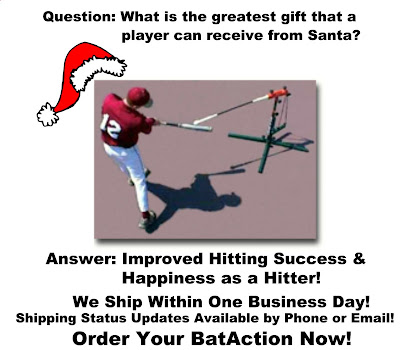 www.BatAction.com
www.BatAction.comBy
Todd ThomasThe latest, greatest training device for young hitters...
...may be EARPLUGS!
So many young hitters and even some of the not so young hitters are so confused at the plate. Why? They are hearing so many people in the ears telling them what to do and not to do mechanically WHILE AT THE PLATE. This is not the time or place to be working on mechanics. It's already hard enough for hitters to make the necessary adjustments needed to what the pitcher is throwing them without their head swimming with what every coach(and parent sometimes not even their own parent) within ear shot telling them what to do or not to do when in the box and when they swing. It's no wonder so many young hitters struggle not only with their swing, but even more tragically in most cases their confidence.
The problem is that most of the time they are hearing a variety of different cues: "swing down", "keep your elbow up", "don't dip your back shoulder", "keep your head down", "you're pulling your head out", "stay tall", "stay back", "swing level", "quit doing (this)", quit doing (that), (insert one you've heard or said here); ...and to add confusion to confidence destruction, some of the things they hear are physically contrary to each other even to actual physics itself. Have you ever tried to "stay back" AND "swing down"? Have you ever tried to "swing level" to a pitch at your knees?
What players should be hearing during game time situations and especially when they are actually at the plate are simple things like "look for something you can hit hard" or "make contact and put the ball in play". Before a player goes to the plate, I like the simple phrase "Don't try to do too much just look for a good pitch to hit and put a good swing on it." Save the intensive mechanical and technique instruction for practice and the cage. Another simple encouraging comment is simply, "Let's go! Make contact and put the ball in play". That's it. Tell them to do. More specifically, tell them what you want them to do, not what you don't want them to do. For example, "Hit the ball hard somewhere"... "Let's go! Hit a line drive"... "Hit the ball to the right side, let's move the runner"... "Drive one to the gap"... "Keep you focus on the ball and put the ball in play"... "Make contact"... "Drive this run in"... (insert your positive message of what you want them to do here)...
There's an old story of a pitcher in a tight situation that was facing a big hitter and his manager came to visit him on the mound. The manager didn't say much. He just said, "Whatever you do, DO NOT throw him anything on the inside half of the plate". The manager returned to the dugout. The first pitch... a fastball on the inside corner... Going, Going, GONE! Instead of planting the seed in that pitcher's mind of where he shouldn't throw the ball, wouldn't it have been better to say something like, "Keep the ball low and away on this guy. You can do it". I think so.
You would be surprised. A lot of young hitters have a very good natural swing and the ability to make on the fly adjustments to what the pitcher has thrown until some coach(es) and/or parents come and take it away from them with either bad hitting "instruction" cues or even good ones but at the wrong time. The problem with even the good ones(as far as mechanical or technique cues) is that the hitter is often hearing contradictory messages coming in the other ear. Now their head is swimming while confidence in what they can actually do is taking a nose dive.
The time to for a hitter to work on their hitting and their swing is at practice and in the cage. For those who think ONE practice a week and ONE trip to the cage a week is good, you should know that the best hitters in the world take batting practice and work on their technique every day! What does that tell you about hitting? It's HARD! Hitting a is a lifelong pursuit. It is something that must be constantly worked on with lots of repetition. Write down this simple phrase and put it somewhere that you see it everyday... Repetition Is The Mother Of Skill.
When it comes to actual instruction and the things we say to hitters or ask them to do, do we tell them why? If a hitter is given a piece of advice, tell them exactly why that is the best thing for them to do. We should show them, demonstrate, and explain why what we're showing them is proper and what they should expect from such technique? How about evidence? Do we show them visual evidence that what we are telling them to do is what the great hitters do? Show them a picture of Alex Rodriguez, Barry Bonds, or Derek Jeter doing what you are asking them to do. Show them. I can hear it already... "these kids are not ARod, they should not be trying be him or trying to do what he is doing. He's a home run hitter." First off.. why not? Secondly, okay then show them Derek Jeter. He's not a home run hitter. Derek has never hit more than 24 HRs in a season and he's only topped 20 HRs three times. He's just a career .317 hitter at the big league level. Show Derek. I guarantee you that Derek's and ARod's techniques are scary similar.
If you don't want your son/daughter/hitters to try to hit like the MLB hitters, that's okay. Show them some pictures of the best collegiate hitters or of the best high school hitters that you know. You might be surprised if you compared the best high school and collegiate hitters to the best big league hitters at what you might see. Similarities! OR... if you don't want to show them evidence of the best hitters at the high school and collegiate level, then show them evidence of average to below average hitters in their sport. It's up to you, but show them some visual evidence that what you are telling them to do is what is right.
I guarantee you kids are not stupid. They watch SportsCenter. Many have Tivo or some kind of DVR. They can stop, rewind, and slowmo. They can see the contradictions of what they often hear and what they are actually seeing the best hitters doing. Unfortunately, the highlights are almost always certainly the best hitters of the sport doing what they do. There aren't too many Highlights of the average or bad hitters so if that's what you want them to show them, you'll have to do that yourself.
Finally... Don't overreact to one at-bat or one game or even a few games for that matter. I doubt the Yankees hitting coach made any major changes to ARod's swing or approach when he struck out FOUR TIMES in one game last season(three of them LOOKING!). It happens. It ALL happens. Watch any big league game and you'll see it all... Strikeouts(swinging and looking)... Pop ups... Fly Balls... Ground Balls... Line Drives... Long Fly Balls.. Bloopers... Dribblers... Bleeders... Texas Leaguers...Home Runs!... Every hitter does all those things, save only for the home runs. Don't overreact or over coach, and in doing so you will give them a better chance to build confidence and succeed. Give or get them good instruction from someone who teaches what the best players at ever level are doing. An instructor's nice resume is just that. Nice. Check out what an instructor is teaching and as Mike Epstein says just ask yourself one simple question in regards to what a coach is telling them to do. And that is... "Does this make sense?"...
Bottom line... Give your young hitters a consistent, positive message about their technique and abilities.
Todd Thomas is a Baseball Coach and Professional Hitting Instructor for Mike Epstein Hitting. Coach Todd's personal hitting website is
http://www.HitItHere.net. Coach Todd also enthusiastically endorses
http://PlayMyBestBaseball.com as a place where baseball and softball hitters can master the Confidence, Composure, Focus and Consistency of their game so they can reach their full potential.
Article Source:
http://EzineArticles.com/?expert=Todd_Thomas BatAction Hitting Machine by Nedco Sports
The "Original Hitting Machine"
100% Guaranteed to Improve Your Hitting...or
You Get Your Money Back"BatAction.comTo order the BatAction Machine...
Click here.

















